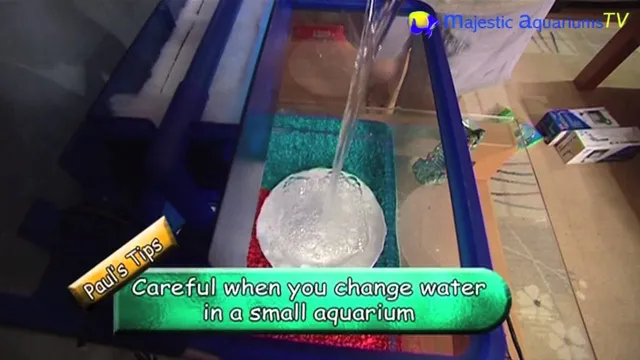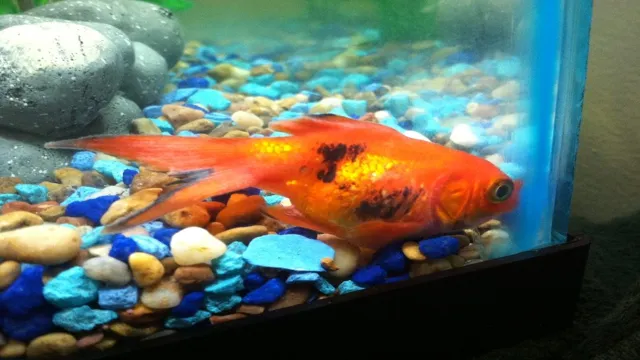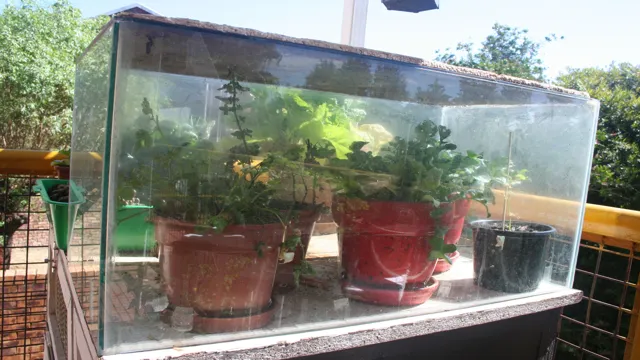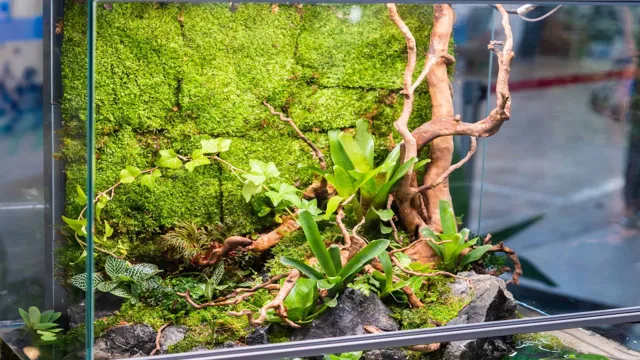Are you tired of constantly cleaning your aquarium plants only to find they are still covered in dirt and grime? Silk aquarium plants are a great alternative to live plants, but they still require cleaning every now and then to maintain their appearance and keep your fish healthy. In this step-by-step guide, we will show you how to effectively disinfect your silk aquarium plants to ensure they are free from harmful bacteria and parasites. We will cover the tools and materials you’ll need, as well as the proper technique to ensure a thorough cleaning without damaging the delicate fabric.
By following these simple steps, you can enjoy the beauty of silk aquarium plants while ensuring a safe and healthy environment for your aquatic pets. So let’s dive in and learn how to clean and disinfect your silk aquarium plants like a pro!
Why disinfect silk aquarium plants?
If you’re a fan of keeping silk aquarium plants, it’s important to know how to disinfect them. Although silk plants are low maintenance and generally easier to take care of than live plants, they can still harbor bacteria and harmful microorganisms. Disinfecting your silk aquarium plants is especially important if you have recently had sick fish in your tank or if you have added new fish to your aquarium.
Disinfection involves using special chemicals or solutions specifically designed to kill off any bacteria, fungus, or other harmful pathogens. By taking the time to disinfect your silk plants, you’ll keep your aquarium environment clean and free from contamination, which is essential for the health and well-being of your fish. So, ensure you disinfect your silk aquarium plants regularly to keep them in their optimal state and create a healthy habitat for your aquatic pets.
Prevents the spread of diseases and parasites
Disinfecting silk aquarium plants is crucial for preventing the spread of diseases and parasites in your aquatic habitat. You might be wondering why this is necessary if your plants aren’t living organisms – but believe it or not, they can still harbor harmful microorganisms and germs. These can easily spread to your fish, causing illnesses and even death.
Additionally, aquatic parasites like anchor worms and fish lice can attach to the surfaces of your plants. If left untreated, they can quickly multiply, leading to a full-blown infestation that can be difficult to eradicate. That’s why it’s vital to regularly disinfect your silk plants using an aquatic-safe disinfectant.
Not only will this keep your aquarium looking its best, but it will also ensure the health and wellbeing of your aquatic pets. Don’t neglect this important aspect of aquarium ownership – invest in proper plant maintenance today!
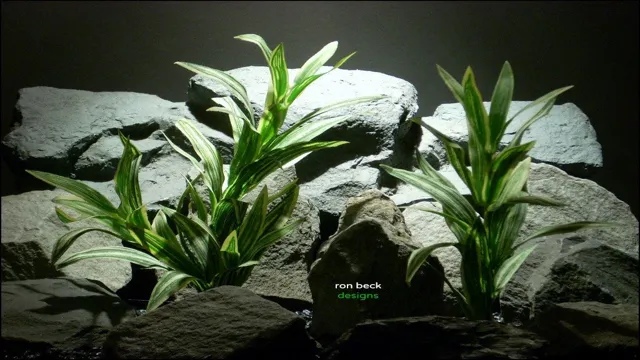
Removes any dirt or debris that may have accumulated on the silk plants
Silk aquarium plants have become increasingly popular for their low maintenance and decorative purposes. However, just like everything else in your aquarium, they can accumulate dirt and debris over time. This is why disinfecting silk aquarium plants is crucial.
It removes any dirt or debris that may have accumulated on the silk plants, ensuring that they remain in good condition, and removing any potential health hazards. This is especially important because aquariums are closed ecosystems, meaning any germs or bacteria can easily spread, harming the fish and other aquatic life. By regularly disinfecting your silk plants, you can ensure a healthier and safer environment for your aquatic friends.
So, the next time you clean your aquarium, don’t forget to give your silk plants a good disinfecting as well!
Materials Needed
Disinfecting silk aquarium plants is important to keep your fish healthy and your tank looking clean. The first step in disinfecting your silk plants is to gather the necessary materials. You will need a bowl or bucket, bleach or hydrogen peroxide, and warm water.
Begin by filling the bowl or bucket with enough warm water to cover the plants and then add a small amount of bleach or hydrogen peroxide. The amount of disinfectant you use will depend on the size of the bowl or bucket and the number of plants you need to disinfect. A good rule of thumb is to use one tablespoon of bleach or hydrogen peroxide for every gallon of water.
Once the solution is mixed, place the silk plants in the bowl or bucket and let them soak for at least 15 minutes. After soaking, rinse the plants thoroughly with clean water several times to ensure that all the disinfectant has been removed. When disinfecting silk plants, it’s important to remember to never use soap or regular cleaning agents, as they can damage the delicate fabric.
By following these simple steps, you can keep your silk plants clean and your aquarium healthy.
Bleach solution (1 part bleach to 19 parts water)
When it comes to cleaning, having the right materials is essential to getting the job done effectively and efficiently. One material that is often recommended for cleaning and disinfecting is a bleach solution consisting of 1 part bleach to 19 parts water. This powerful solution can kill a range of germs and bacteria, making it ideal for use in spaces that require high levels of sanitation.
To create the solution, you will need bleach (preferably a concentrated version) and water. It’s important to note that gloves and protective eyewear should be used when handling bleach to avoid skin and eye irritation. Additionally, the solution should be mixed in a well-ventilated area to avoid inhaling fumes.
With the right materials and precautions, using a bleach solution can help create a clean and healthy environment for your home or workspace.
Bucket or container large enough to hold the silk plants
When it comes to arranging silk plants, having the right tools by your side can make all the difference! The most important thing you’ll need is a bucket or container that’s big enough to hold all of your plants. This will serve as your workspace and make it easier to move the plants around as you arrange them. You’ll also want to have a pair of scissors or wire cutters to trim the stems of your silk plants, allowing you to create a more natural and realistic look.
Another useful material is foam or floral foam, which can be used to anchor your plants in place and provide support. With these few essential materials, you’ll be well on your way to creating stunning silk plant arrangements! So, what are you waiting for? Let’s get crafting! (See Also: How to Catch a Lizard in Aquarium: Tips and Tricks for Success)
Gloves
If you want to make your own gloves, there are a few materials you’ll need to get started. First and foremost, you’ll need fabric or leather to create the actual glove. Opt for a durable and flexible material that won’t easily wear and tear.
You’ll also need thread to stitch together the various parts of the glove. It’s important to choose a strong thread that won’t easily break or fray over time. Additionally, you’ll need a cutting tool, such as scissors or a rotary cutter, to cut out the fabric or leather pieces to the right size.
Finally, you may want to invest in some extra materials for decoration, like buttons, beads, or embroidery floss. With these basic materials, you’ll be able to create a custom pair of gloves that fits your hands perfectly and suits your personal style. Happy crafting!
Sponge or soft-bristled brush
When it comes to cleaning your home, having the right materials is essential. One of the most important tools you will need is either a sponge or a soft-bristled brush. These tools are versatile and can clean a variety of surfaces without causing damage.
Sponges are great for wiping down surfaces, cleaning dishes, and scrubbing away dirt and grime. Soft-bristled brushes are ideal for cleaning delicate or intricate items, such as glassware, artwork, or electronics. They are also useful for removing stains and dirt from carpets and upholstery.
When choosing between a sponge and a brush, consider the surface you are cleaning and the level of dirt or grime present. If the surface is delicate, such as a precious vase or a computer screen, then a soft-bristled brush is the better choice. But if the surface is tough and durable, a sponge may be more effective in removing dirt and grime.
Overall, having both tools at your disposal can help ensure that your home stays clean and well-maintained.
Step-by-Step Guide
Want to disinfect your silk aquarium plants but don’t know where to start? Don’t fret! Here’s a step-by-step guide on how to safely disinfect your silk plants and ensure your aquarium stays clean and healthy for your fish. First, remove the silk plants from your aquarium and rinse them with warm water to remove any surface debris. Then, soak them in a 10% bleach solution for 10-15 minutes, making sure to thoroughly rinse them afterwards.
Alternatively, you can use a commercial aquarium disinfectant according to the manufacturer’s instructions. Be sure to never use soap or detergent, as this can leave harmful residue on the plants. Once thoroughly rinsed, you can safely add the silk plants back into your aquarium.
It’s important to disinfect your decor regularly to prevent the buildup of harmful bacteria and maintain the health of your aquatic pets. With these simple steps, maintaining a clean and healthy aquarium has never been easier!
Step 1: Remove silk plants from the aquarium
If you’re looking to redesign your aquarium, one of the first things you’ll want to do is remove any silk plants inside of it. While these fake plants might have added a touch of vibrancy to your tank, they can quickly become dingy and dirty, detracting from its overall aesthetic. Luckily, removing silk plants from your aquarium is a simple process that won’t take too much time or effort.
Firstly, you’ll want to carefully lift the plants out of the water, making sure not to disturb the surrounding gravel or sand. Once you’ve done this, gently rinse the plants under lukewarm water. Be sure to remove any algae or debris that may have collected on them.
Once the plants have been cleaned, you can safely set them aside or dispose of them as needed. By taking the time to remove and replace your old silk plants, you’ll be well on your way to giving your aquarium the facelift it deserves.
Step 2: Rinse the plants with warm water to remove any dirt or debris
When it comes to caring for your indoor plants, it’s important to keep them clean and free from debris. That’s where step two comes in: rinsing your plants with warm water. This step helps to remove any dirt or dust that may have settled on the leaves or stems.
To do this, simply place your plant under a gentle stream of warm water in the sink or shower. Be sure to avoid using hot water or any harsh chemicals, as these can damage the delicate leaves of your plants. You can also use a damp cloth to wipe down any leaves that may have accumulated dirt or dust.
By taking the time to rinse your plants regularly, you’ll help them stay healthy and vibrant for years to come.
Step 3: Prepare the bleach solution (1 part bleach to 19 parts water)
When it comes to preparing the bleach solution for your laundry, there are a few important things to keep in mind. First and foremost, it’s essential to use the right ratio of bleach to water – in most cases, you’ll want to aim for one part bleach to 19 parts water. This will help to ensure that your clothes are cleaned properly without getting damaged by the bleach.
To prepare the solution, you’ll need to mix the bleach and water together thoroughly in a separate container before adding it to the washing machine or soaking your clothes. Depending on the size of your load and the specific instructions on your bleach product, you may need to adjust the amount of solution you create. Additionally, it’s important to note that bleach should never be mixed with other cleaning products, as this can create dangerous fumes. (See Also: How to Clean Natural Rocks for Aquarium: Tips and Tricks)
By following these simple steps and taking the time to prepare your bleach solution correctly, you can ensure that your clothes come out looking bright, clean, and fresh every time.
Step 4: Place the silk plants in the bucket or container and add the bleach solution
After you’ve mixed the bleach solution, it’s time to add the silk plants to the bucket or container. Make sure the plants are fully submerged in the solution and leave them to soak for several hours. While the plants are soaking, you can agitate the solution gently to make sure it reaches every part of the plant.
Keep in mind that bleach can cause discoloration, so it’s essential to check the plants regularly to ensure they don’t become too white or faded. Once you’re satisfied with the level of cleaning, remove the plants from the solution and rinse them thoroughly with clean water. You can then let them air dry or use a soft cloth or paper towel to dry them more quickly.
Remember to handle the plants gently and avoid rubbing or scrubbing them too hard, as this can cause damage. With these simple steps, you can have beautifully clean and vibrant silk plants that will brighten up any room of your house.
Step 5: Let the plants soak in the bleach solution for 10-15 minutes
Now that you’ve prepared your bleach solution and gathered your plants, it’s time to let the plants soak. This step is crucial for effectively sterilizing your plants and removing any unwanted pests or pathogens. Simply place your plants into the bleach solution and let them soak for 10-15 minutes.
It’s important to not leave your plants in the solution for too long, as this can damage the plant’s roots and leaves. During this time, take a break and do something else while the solution works its magic. After the time is up, remove the plants from the solution and rinse them thoroughly with clean water.
Now your plants are ready to be re-planted or used for your desired purpose. Don’t forget to properly dispose of the bleach solution, and wash your hands thoroughly after handling the solution. With this simple step, you can ensure that your plants are free from pests and pathogens, and ready to thrive in their new environment.
Step 6: Rinse the plants thoroughly with warm water
After soaking and agitating the plants thoroughly, it’s time to finish the cleaning process by rinsing them with warm water. This step is essential because it removes any remaining dirt, debris, or soap that may have clung to the plants during the previous steps. Be sure to rinse them well and allow the water to run over the plants until it comes out clear.
Using warm water helps to remove all the loosened debris and soap, resulting in clean and healthy plants that are ready to be re-homed. Additionally, the warm water can help to revive tired or wilted plants by providing them with a refreshing drink. Don’t forget to give them a gentle shake to remove excess water before letting them dry thoroughly in a warm and airy place.
With this final step, your plants will be looking their best and ready to become the centerpiece of your home once again.
Step 7: Use a sponge or soft-bristled brush to gently clean any remaining debris or dirt
When it comes to cleaning your outdoor living spaces, it’s essential to follow a step-by-step process. After sweeping your patio or deck, the next step is to use a sponge or soft-bristled brush to gently clean any remaining debris or dirt. This step is crucial, as it ensures that any dirt or grime left on the surface doesn’t get ground in over time.
Using a sponge or brush allows you to apply just enough cleaning pressure to remove the debris without damaging the surface. Whether you’re cleaning your patio or deck, it’s essential to take your time and be gentle. Something as simple as using the wrong brush or scrubbing too hard can damage the surface, leading to costly repairs down the line.
So, take your time, use the right tools, and enjoy a clean outdoor space that you can be proud of.
Step 8: Rinse the plants again with warm water
Now that you have completed the soaking process, it’s time to rinse the plants again with warm water. This step is crucial to ensure that all the soap residue is removed from the plants. You don’t want any soap left on the leaves, as it can harm or even kill them.
Rinse each plant thoroughly, making sure that every part is covered and all soap residue is removed. You can use a gentle spray or a showerhead for this step, but be gentle to avoid damaging the plants. Once you are done rinsing, gently shake off any excess water and let the plants air dry for a few hours.
By following all the steps of this guide, you can rest assured that your plants will be clean and healthy. Remember, cleanliness is essential for maintaining a healthy and thriving garden!
Final Thoughts
In conclusion, disinfecting silk aquarium plants is a crucial step in maintaining a healthy aquatic environment for your fish and other aquatic life. When choosing a disinfectant, opt for a mild and safe option that won’t harm the plants or aquatic life in your tank. Always follow the instructions on the package for the best results.
It’s also essential to keep the disinfecting solution away from pets and children and to properly dispose of any leftover solution. By following these steps, your silk plants will remain clean and vibrant while keeping your aquarium healthy and thriving. Remember, a little effort goes a long way in ensuring the safety and wellbeing of your aquatic pets. (See Also: How to Kill Aquarium Cyclops: Effective Methods for Eliminating these Pests)
So, keep up the good work!
Be sure to thoroughly rinse the silk plants to remove any remaining bleach residue before returning them to the aquarium
Silk Plants Cleaning in Aquarium Silk plants can be a great addition to any aquarium because they add a natural touch without the hassle of real plants. However, they can also harbor bacteria and algae, which can be harmful to the fish. Therefore, it is essential to clean silk plants regularly to ensure a healthy and safe environment for the fish.
One effective cleaning method is using bleach. However, it is crucial to be cautious and use the right amount of bleach to avoid damaging the silk plants. After using bleach, make sure to rinse the plants thoroughly to get rid of any residue.
When returning the plants to the aquarium, inspect them carefully to ensure that they’re free from any bleach residue. By taking proper care of your silk plants, you can enhance the visual appeal of your aquarium and provide a healthy living environment for your fish.
Disinfecting silk aquarium plants should be done on a regular basis to ensure the health of your aquatic pets
Silk aquarium plants are a great alternative to live ones as they offer a realistic look without the upkeep. However, just like live plants, silk aquarium plants also require proper care and maintenance. A neglected silk plant can lead to the spread of harmful bacteria and toxins in your tank, which can cause harm to your aquatic pets.
Thus, it is crucial to disinfect your silk aquarium plants on a regular basis. But, keep in mind not to use harsh chemicals as they can cause damage to the delicate silk fibers. You can use hydrogen peroxide or white vinegar to disinfect your silk plants.
Additionally, never forget to rinse the plants thoroughly after disinfecting to ensure the safety of your aquatic pets. By taking these small steps, you can keep your silk aquarium plants healthy and free from any harmful bacteria, ensuring a clean and safe environment for your aquatic pets to thrive in.
Conclusion
In conclusion, taking care of our aquatic pets and their environment is crucial to their health and wellbeing. But don’t let the delicate nature of silk aquarium plants scare you away from proper disinfection! With a few simple steps and the right tools, you can keep these plants as clean and vibrant as the day you bought them. So go ahead and give them a good scrub, rinse, and dry – your fish will thank you for it!”
FAQs
Can silk aquarium plants be disinfected?
Yes, silk aquarium plants can be disinfected using a few simple steps.
What is a safe disinfectant to use on silk aquarium plants?
A safe disinfectant to use on silk aquarium plants is a diluted bleach solution or hydrogen peroxide.
How do I make a diluted bleach solution to disinfect silk aquarium plants?
To make a diluted bleach solution, add one-part bleach to ten-parts water.
How do I use hydrogen peroxide to disinfect silk aquarium plants?
To use hydrogen peroxide, simply soak the silk aquarium plants in a solution of one-part hydrogen peroxide to ten-parts water for 10 to 15 minutes.
Can I use rubbing alcohol to disinfect silk aquarium plants?
No, rubbing alcohol can damage the silk material of aquarium plants and is not a safe disinfectant to use.
How often should silk aquarium plants be disinfected?
Silk aquarium plants should be disinfected at least once every month or whenever you notice any signs of algae or bacteria growth.
Is there an alternative to disinfecting silk aquarium plants?
Yes, you can also use hot water to disinfect silk aquarium plants by soaking them in hot water for 10-15 minutes. Make sure the water temperature is not too hot to avoid damaging the silk material.



